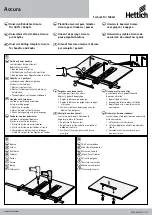
2
For your safety and the safety of others, read and under-
stand the safety recommendations and operating instruc-
tions before operating an Airetrol.
Safety Recommendations
For additional information on eye and face protection, re-
fer to Federal OSHA Regulations, 29 Code of Federal Regu-
lations, Section 1910.133., Eye and Face Protection, and
the American National Standards Institute, ANSI A87.1,
Occupational and Educational Eye and Face Protection.
Z87.1 is available from the American National Standards
Institute, Inc., 1430 Broadway, New York, NY 10018.
Hearing protectors are required in high noise areas, 85
dBA or greater. The operation of other tools and equip-
ment in the area, reflective surfaces, process noises and
resonant structures can substantially contribute to, and in-
crease the noise level in an area. For additional informa-
tion on hearing protection, refer to Federal OSHA Regula-
tions, 29 Code of Federal Regulations, Section 1910.95,
Occupational Noise Exposure, and American National Stan-
dards Institute, ANSI S12.6 Hearing Protectors.
Airetool Airetrols are designed to operate on 90 psig (6.2
bar) maximum air pressure. If the tool is properly sized
and applied, higher air pressure is unnecessary. Exces-
sive air pressure increases the load and stresses on the
tool parts, which may result in cage, mandrel or roll break-
age. Installation of a filter-regulator-lubricator in the air sup-
ply line ahead of the tool is recommended.
Before the tool is connected to the air supply, check the
throttle for proper operation (i.e., throttle moves freely and
returns to the closed position). Clear the air hose of accu-
mulated dust and moisture. Be careful not to endanger
adjacent personnel. Before removing a tool from service
or changing sockets, make sure the air line is shut off and
drained of air. This will prevent the tool from operating if
the throttle is accidently engaged.
It is essential for the safe operation that the operator of an
Airetrol use good balance, sure footing, and proper pos-
ture in anticipation of the torque reaction. Insure that the
operator’s hand will not be wedged or pinched between
the work and the tool when operating.
Tools with clutches can stall rather than shut-off if adjusted
over the maximum power output of the tool, or if there is a
drop in air pressure. Operator must then resist the stall
torque until the throttle is released.
Higher torque right angle Airetrols are supplied with a
splined torque reaction mounting plate and reaction bar
complete. ALWAYS USE WITH REACTION BAR DEVICE
SUPPLIED WITH THE AIRETROL! These bars can be
braced against the work or other suitable points to absorb
and relieve the operator of the torque reaction transmitted
by the tool. Tool balance arms are also available to absorb
the torque reaction of the tool while balancing the weight
of the tool for improved ergonomic applications.
Some individuals are susceptible to disorders of the hands
and arms when exposed to tasks which involve highly re-
petitive motions and/or vibration. Those individuals predis-
posed to vasculatory or circulatory problems may be par-
ticularly susceptible. Cumulative trauma disorders such as
carpal tunnel syndrome and tendonitis can be caused or
aggravated by repetitious, forceful exertions of the hands
and arms. These disorders develop gradually over periods
of weeks, months and years.
When using right angle Airetrols, be sure the throttle is
positioned relative to the angle head so that the throttle will
not become wedged against an adjacent object in the “ON”
position due to torque reaction. The angle head may be
repositioned with respect to the lever to accomodate proper
location for the task. If tool is to be reversed, locate throttle
lever in a neutral position that will prevent entrapment. Refer
to operating instructions for additional information.
Summary of Contents for Airetool 2055-R Series
Page 11: ......






























